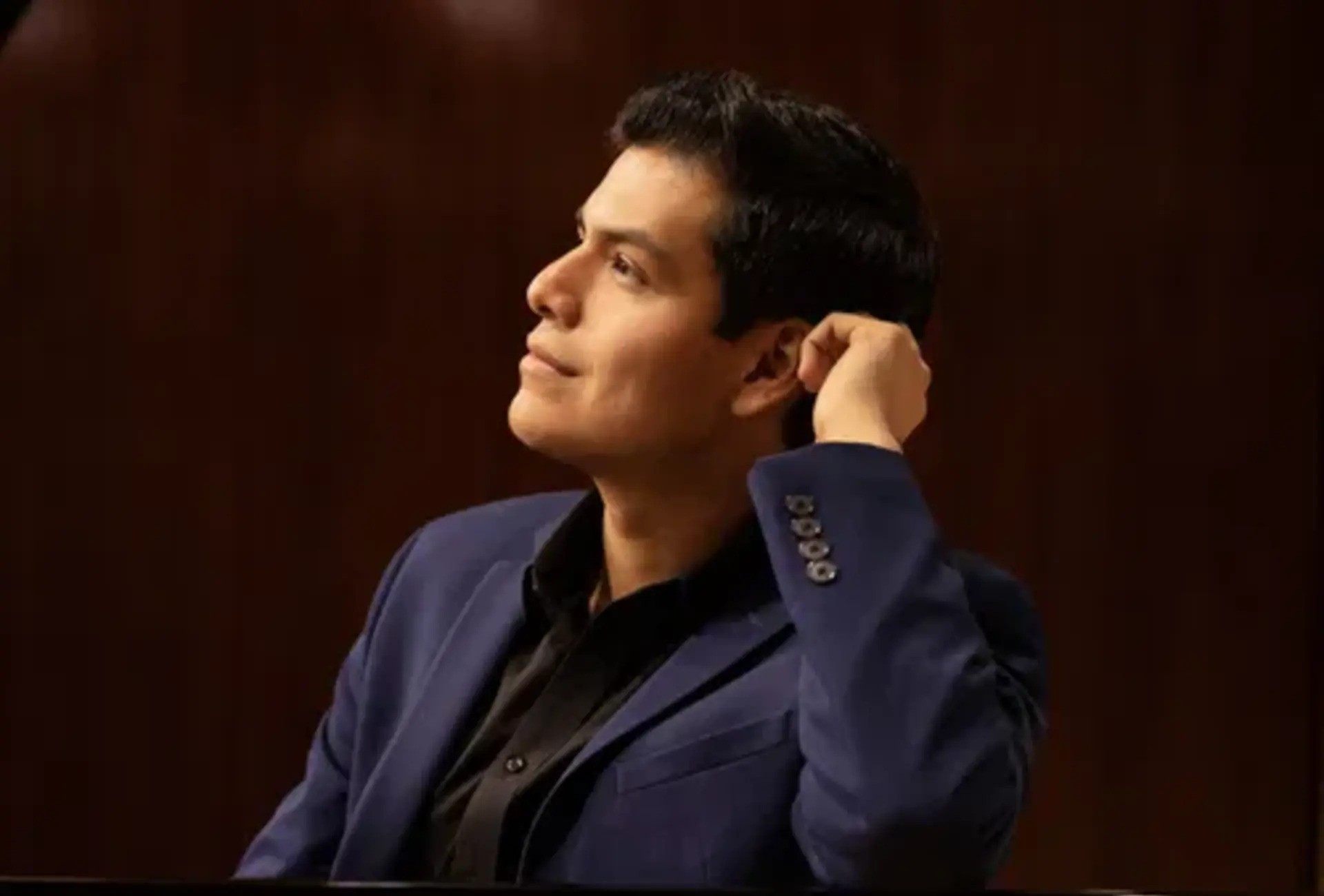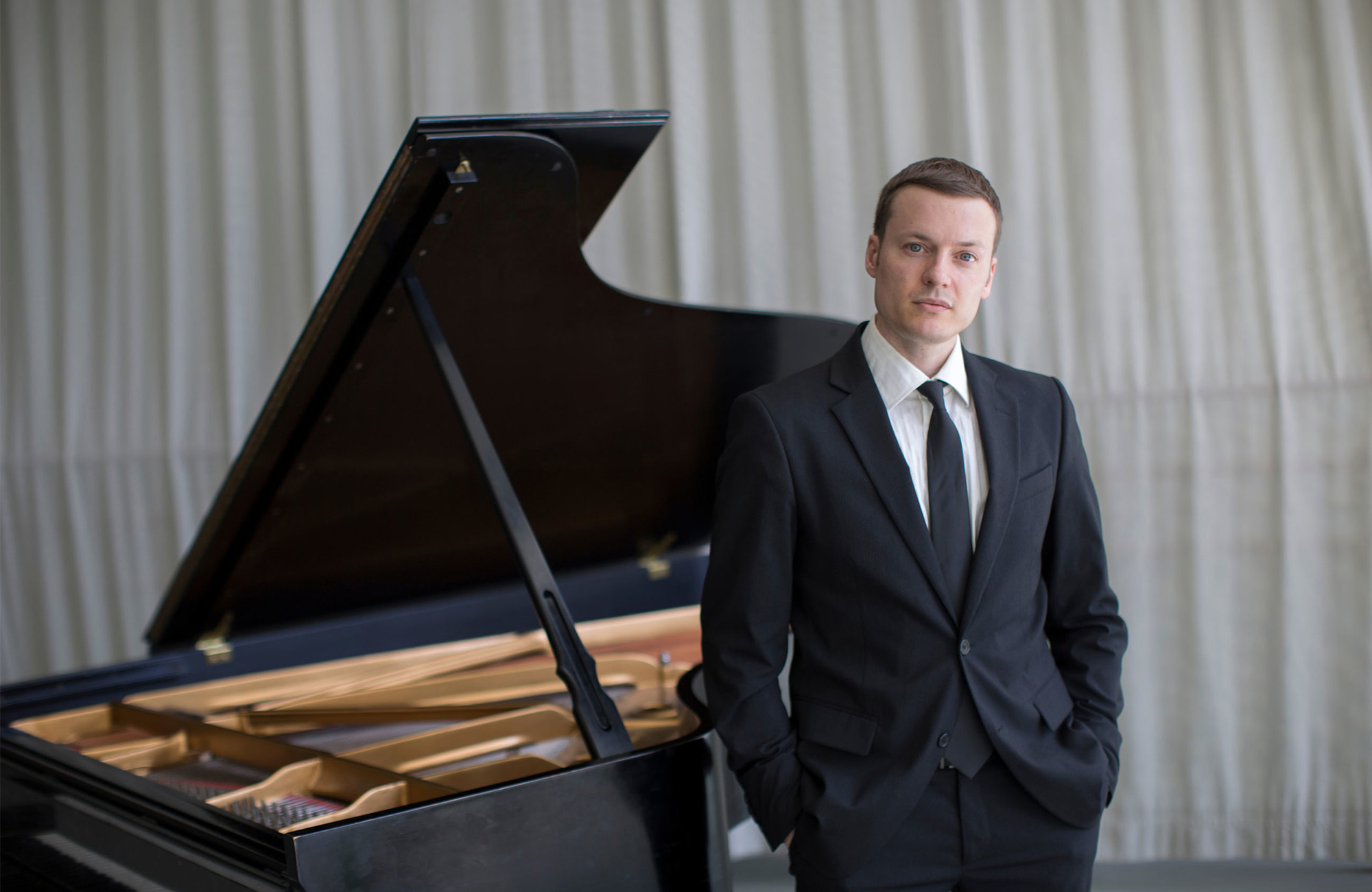Click “play” below for “Passacaglia: Secret of Wind and Birds.”
The Syracuse Orchestra presents an evening of animal-themed music! We begin with Saint-Saens’ Carnival of the Animals and 14 animals represented through the performance of pianists Aaron Wunsch and Giancarlo Llerena. Explore the Secret of the Wind and Birds from Tan Dun, who also composed the Academy Award-winning music for “Crouching Tiger, Hidden Dragon”. In Elgar’s Enigma Variations, listen for musical references that communicate personality traits of 14 of his friends (with a special musical homage to a friend’s beloved bulldog!)
PROGRAM
SAINT-SAENS: Carnival of the Animals![]()
LISZT: Totentanz![]()
DUN: Secret of Wind and Birds
ELGAR: Enigma Variations![]()
Thank you to our generous sponsors!
Thank you to our PEC, Inc. Masterworks Series sponsors:
Masterworks Series Sponsor:
Exclusive Auto Sponsor:
Masterworks Series Media Sponsor:
Thank you to our concert sponsors!
David Abrams, in memory of Cheryl Abrams
PROGRAM NOTES
At this year’s first Masterworks concert, we presented one of the grandest and most serious works by Camille Saint-Saëns (1835–1921), his Third Symphony, generally known as the “Organ” Symphony. We return to Saint-Saëns for tonight’s opener, offering a work as frivolous as the symphony is grand: Carnival of the Animals. It was composed in the same year as the symphony, 1886, although Saint-Saëns wouldn’t allow it to be published or performed in public until after his death. Why? He wrote it as a jeu d’esprit—and ...
At this year’s first Masterworks concert, we presented one of the grandest and most serious works by Camille Saint-Saëns (1835–1921), his Third Symphony, generally known as the “Organ” Symphony. We return to Saint-Saëns for tonight’s opener, offering a work as frivolous as the symphony is grand: Carnival of the Animals. It was composed in the same year as the symphony, 1886, although Saint-Saëns wouldn’t allow it to be published or performed in public until after his death. Why? He wrote it as a jeu d’esprit—and he was afraid that its humor would injure his reputation as a serious composer. His fears were justified; once published, it went on to become his most popular large-scale work and has contributed to an underestimation of the depth of his output as a whole.
Part of its appeal is its wacky orchestration. Saint-Saëns was no stranger to throwing together unusual ensembles (his Septet, written a few years earlier, plumps up the standard piano quintet with double bass and trumpet). But Carnival of the Animals may be the most unorthodox, calling for an ensemble of 11 instruments: flute, clarinet, glass harmonica, xylophone, string quintet, and two pianos. It’s deployed in an imaginatively varied way, too: Every one of its fourteen sections (except for “Wild Asses,” “Kangaroos,” and “Pianists,” which are played by the two pianos alone) is scored for a different collection of players—and the whole ensemble only gets together when the piece is summed up in the effervescent finale.
Indeed, the ensemble is so unorthodox that it’s impractical—so you’re unlikely to hear the work in its original scoring. The glass harmonica, for instance, is nearly extinct. Invented by Benjamin Franklin, it uses wet fingers against spinning bowls to produce eerie sounds (just as you can produce sounds by running a wet finger around the rim of a wine glass); nowadays, it’s usually replaced by a glockenspiel (as it will be tonight) or by a celesta. Then, too, since the ensemble is too large and diverse for a chamber music concert and too small for most symphonic concerts, it’s usually played with a larger string section.
Part of its attraction, too, is its appeal to young listeners, which is why it’s a staple on kids’ concerts. As pianist Aaron Wunsch describes it, it inspires “the childlike glee of going to the zoo. You see these animals and how they’re behaving, and your eyes widen.” At the same time, though, it’s aimed at experienced listeners. For all its immediacy and child-like wonder, much of its humor is fairly sophisticated, and it often relies on a sharp ear and musical knowledge.
Yes, the lumbering of the double-bass in “The Elephant” will elicit a smile, even to an uninitiated youngster; but the real humor in the movement is its incongruously weighty quotations of Berlioz’s gossamer “Dance of the Sylphs” (from Damnation of Faust) and of ethereal music from Midsummer Night’s Dream. Similarly, the “Tortoises” dance to a slow distortion of the familiar “Can-Can” from Offenbach’s Orpheus in the Underworld, while “Fossils” not only imitates the bones of skeletons and Saint-Saëns’s own Danse Macabre, but also a few fossilized folk songs as well as a Rossini aria—a remnant of an earlier time.
The connections between Saint-Saëns’ Carnival of the Animals and our second composer tonight, Franz Liszt (1811–1886), are labyrinthine. The two composers were what Liszt called “excellent friends” who performed each other’s music; and one of the last musical events that Liszt attended was one of those private performances of Carnival of the Animals when it was first composed. There’s a good chance that Liszt would have been particularly amused by the way Saint-Saëns wove in the Danse macabre, since Liszt himself had transcribed the work for piano a decade earlier—perhaps a nod of thanks to Saint-Saëns who had transcribed Liszt’s tone poem Orpheus for piano trio the year before. Then, too, at the time, Saint-Saëns was also composing his Organ Symphony, which was inspired by Liszt’s compositional procedures and dedicated to him.
That said (and there’s much more), it’s something of a shock to move from the high-spirited jaunt that concludes Carnival of the Animals to Liszt’s Totentanz (The Dance of Death, c. 1847–1864), our second work tonight: Liszt’s is as terrifying as Saint-Saëns’s is lighthearted.
To be sure, on the surface, Totentanz is a pianistic showpiece. Yet the piece is no simple virtuoso vehicle. Indeed, it represents much of Liszt’s most radical rethinking of compositional techniques in the middle of the nineteenth century, looking ahead in some ways to the twentieth. Harmonies can be shocking. Formally, too, the work breaks with tradition. It begins as a simple theme and variations—thus tying it formally to the last two pieces on the program; but about halfway through, with the fifth variation, the structure seems to dissolve into something more like a free fantasia.
At the same time that it looks ahead, however, the music is strongly anchored in the past—although not in the fossilized manner that Saint-Saëns poked fun at. It has its programmatic source in a fourteenth-century fresco (attributed at the time to Andrea di Cione di Arcangelo, familiarly known as Orcagna), and perhaps in Holbein etchings as well. The basic musical material is ancient as well. Under the influence of another good friend Hector Berlioz, who had used the same theme in his Symphonie fantastique, Liszt grounds Totentanz in the Dies Irae, the plain-chant from the Latin Requiem Mass used to describe the “day of wrath.” (Just to tighten the connections between Saint-Saëns and Liszt, both Danse macabre—although not the part quoted in Carnival of the Animals—and the “Organ” Symphony quote the Dies Irae, too; and Carnival of the Animals quotes Berlioz as well, an excerpt from his opera-oratorio about Divine Judgment.) Then, too, Liszt alludes to stylistic procedures of pre-classical composers, especially Bach. This superimposition of the future and the past produces a kind of temporal disorientation—perfectly appropriate to a work reflecting the Day of Wrath.
Aaron has a special connection to the piece: “I heard it for the first time when I was twelve. It’s one of the most long-lasting musical experiences I ever had—it has stayed with me, even to this day. It may be one of the reasons why I became a pianist.” In fact, he went on to study with the soloist who performed it at that concert—Robert Moeling. (By a bizarre coincidence, Carnival of the Animals was also played on that fateful concert.)
What’s so compelling about Totentanz? “From the very moment that this piece started,” says Aaron, “I was on the edge of my seat. The way that Liszt uses the piano, from the start, grabs hold of you as a listener and captivates you.” Wouldn’t any virtuoso work have had the same effect? No, he says. “It sounded dangerous. The opening, where the pianist runs up and down the keyboard, was like an electric shock. I had never heard classical music that grabbed me like that. There’s something so visceral about the way he uses the piano in every possible expressive format. At the start, you can’t even hear the notes—it’s almost like a percussion instrument. And the speed of some of it is so fast, you can’t hear the individual notes either. He’s using sonic effects on the piano that I didn’t realize were possible at that time.
“And of course,” he continues, “the music is about death, a subject that we tend to not want to talk or think about—and it tries to meet that subject head on. When we’re forced to think about death, what comes to mind first is fear. And Liszt summons that in the listener in an amazing way, through noise, through sheer speed, volume, dissonance, and then he reflects on it more deeply. What is this? What does it mean when we die? What happens to us? Where do we go? Is there an afterlife? There’s this very contemplative section in the middle where he considers some of those things.”
If Totentanz probes the depths, the Passacaglia: Secret of Wind and Birds by Tan Dun (b. 1957) soars across the sky. Tan is probably most widely known for his film score for Crouching Tiger, Hidden Dragon. But he’s written a vast amount of music, from solo pieces to operas, notable for combining Chinese and Western musical instruments and traditions. In Passacaglia: Secret of Wind and Birds, as in his multimedia works, he incorporates modern technology too, calling on cell phones (both in the orchestra and in the audience) to play back, in the composer’s words, the sounds of “six ancient Chinese instruments, the guzheng, suona, erhu, pipa, dizi, and sheng.” Specifically, they play bird sounds he composed, “turning the devices into instruments and creating a poetic forest of digital birds.”
In spirit, the aim of the work is “to decode the countless patterns of the sounds and colors found in nature,” in particular the way birds, winds, and waves travel. Formally, the work, like the Liszt (and the Elgar that closes the concert), is a set of variations—more specifically, a passacaglia, which is a set of variations that appears over a repeated bass line. The variations are of different lengths, often separated by brief interludes. But it’s easy to follow the music’s progress, since the basic pattern, initially called out by the first trombone, is clearly audible throughout, drawing you inexorably ahead. After the ninth variation, the orchestra begins chanting and builds, in Tan’s words, with “finger snapping, whistling, and foot stamping into a powerful orchestral hip-hop energy. By the end, the winds, strings, brass, and percussion together cry out as one giant bird. To me, this last sound is that of the Phoenix, the dream of a future world.”
In addition to the digital overlay, the orchestra itself—like the piano in Totentanz—will, in the words of tonight’s conductor José-Luis Novo, be doing “many unconventional things”: “They are going to be humming, whistling, snapping their fingers, and creating sounds that are more unusual.” After the first variation, for instance, the score asks the strings to “improvise on the sound of ocean … wind … birds.” “I believe,” continues José-Luis, “that it’s very important to show the audience that an orchestra is a versatile instrument that can do lots of things.” It’s that orchestral versatility, combined “with the involvement of the audience themselves participating in the creation of the performance,” that led to him to choose this piece for tonight’s concert.
Passacaglia: Secret of Wind and Birds ends in flight; the Enigma Variations, composed in 1898–1899 by Edward Elgar (1857–1934) brings us back to earth. On the surface, the work is a straightforward set of 14 variations based (sometimes loosely) on a theme stated at the outset. But although it’s straightforward, it’s ingenious; as José-Luis says, “the piece is an incredible exercise on how to create music out of small content.” The work runs deeper than that, however: every variation, headed by initials or a nickname, represents someone in Elgar’s circle, starting with his wife Alice, moving through publisher August Jaeger (the famous “Nimrod” variation in the middle, punning on the meaning of the German word jaeger, “hunter”), ending with a tribute to the composer himself (surprisingly assertive, given Elgar’s modesty). Some friends are honored with variations tied to their general personalities, some with representations of personal quirks (the stammer of Dora Penny, Variation 10), others with reminiscences of events (George Sinclair’s bulldog falling into a river, Variation 11).
But there’s yet another level, suggested most clearly by the erotic pull in the evocative Variation 13, a romanza in which the initials are replaced by asterisks (always a clue of something risqué) and in which Elgar quotes Mendelssohn’s “Calm Sea and Prosperous Voyage” in a way tinted with loss and melancholy. Need more mystery? Elgar claimed that there was a secret theme behind the main theme—in other words, that the theme was already a variation on something else. Critics and musicologists have spent more than 125 years trying to solve the puzzle, proposing dozens of solutions from “Twinkle, Twinkle, Little Star” to the theme from Bach’s Art of Fugue. It increasingly seems that we’ll never know the answer—and even that Elgar may have been sending us on a wild goose chase.
With all these layers, the work offers abundant opportunities for the listener. Even if you just bask in the music as it unfolds, however, you’ll be following the composer’s guidance. “The work,” he wrote, “may be listened to as a ‘piece of music’ apart from any extraneous consideration.”
In any case, the Enigma Variations provides the perfect end to this concert, since it mirrors Carnival of the Animals in uncanny ways. Both works are the most popular large-scale works that their respective composers wrote; the Saint-Saëns has fourteen sections, the Elgar fourteen variations; thanks to the intrusion of George Sinclair’s bulldog, both represent animals; both quote Mendelssohn; and they both reach their mysterious romantic core at the same point, the unlucky No. 13 (that’s where “The Swan” shows up in Carnival of the Animals). Then, too, both are, in José-Luis’s words, “collections of portraits.” You might almost suspect that Carnival of the Animals holds the key to Elgar’s enigma.
Peter J. Rabinowitz
Have any comments or questions? Please write to me at prabinowitz@SyracuseOrchestra.org
FEATURED ARTISTS

Pianist Aaron Wunsch enjoys a multifaceted career as a performer, presenter, and educator. He has performed on concert stages throughout the US, Europe and Asia, including in Avery Fisher Hall at Lincoln Center, Weill Hall at Carnegie Hall, Duke’s Hall in London, at the Verbier Festival in Switzerland ...
Pianist Aaron Wunsch enjoys a multifaceted career as a performer, presenter, and educator. He has performed on concert stages throughout the US, Europe and Asia, including in Avery Fisher Hall at Lincoln Center, Weill Hall at Carnegie Hall, Duke’s Hall in London, at the Verbier Festival in Switzerland and as soloist with symphonies in the US and China. Lauded for his “masterful” chamber music performances (Hartford Courant), he has appeared at the Norfolk, Bowdoin, Sarasota, Great Lakes and Yellow Barn chamber music festivals, collaborating in performance with cellist Lynn Harrell, clarinetists Charles Neidich and Anthony McGill, violinists Miranda Cuckson and Jennifer Koh, and the Miró and Parker Quartets, among others. He has worked closely with many composers, including Thomas Adès, Nico Muhly, and Kaija Saariaho and has performed new works by Saariaho and John Adams during Tanglewood’s Festival of Contemporary Music. His performances have frequently been heard nationally on Performance Today.
He studied at Yale University (B.A., cum laude), the Mozarteum in Salzburg (Fulbright Fellowship) and at the Juilliard School (M.M. and D.M.A.). He was formerly Assistant Professor of Piano at William Paterson University and is currently the Director of Keyboard Studies and Piano Curriculum at Juilliard, where he teaches piano literature, graduate studies, chamber music, and directs Juilliard PianoScope, the Piano Department’s performance series. He gives piano master classes and lectures at conservatories and universities in the U. S., Europe, and Asia, and he was 2010 Visiting Professor at Shanghai Normal University. His awards for written work in musicology include the Henry Hart Rice Prize and the Richard F. French Prize. His principal teachers in piano included Peter Frankl, Karlheinz Kämmerling, and Robert McDonald, and he also worked with Andras Schiff, Jerome Lowenthal, and Claude Frank; his history and theory studies were with Allen Forte, Robert Morgan, L. Michael Griffel, and Maynard Solomon.
He is Artistic Director of both the acclaimed Music Mondays concert series in New York City and Co-Artistic Director of the Skaneateles Festival, in the Finger Lakes.

New York-based Peruvian American, Giancarlo Llerena, is a pianist, collaborator, teaching artist, and aspiring leader in the arts. An avid performer, he has appeared on many prestigious stages across the US and Europe, such as Carnegie Hall, Alice Tully Hall, the Kravis Center, the New World Center, Teatro Angelo ...
New York-based Peruvian American, Giancarlo Llerena, is a pianist, collaborator, teaching artist, and aspiring leader in the arts. An avid performer, he has appeared on many prestigious stages across the US and Europe, such as Carnegie Hall, Alice Tully Hall, the Kravis Center, the New World Center, Teatro Angelo Mariani, Église Saint Dominique, and more. Most recently, he has appeared in performance twice with violinist Joshua Bell, as well as soprano Larisa Martinez for the Venezuelan American Endowment for the Arts Gala. In the 2024-2025 season, he also had the privilege of performing alongside “You Raise Me Up” singer, Josh Groban.
Giancarlo has been awarded top prizes in several competitions, including the National Youngarts Competition, and has also attended the Tanglewood Institute and the Aspen Music Festival on full scholarship. He was recently invited as a 2025 Fellowship Pianist for Classic Lyric Arts, where he coached and performed with singers across Italy and France. Throughout his journey, he has had the privilege of being mentored by many esteemed musicians, such as Hilary Hahn, Jessie Montgomery, Brian Zeger, Isabel Leonard, Rohan de Silva, Itzhak Perlman, David Finckel, Jean-Yves Thibaudet, and others.
Having immense passions for music pedagogy and bringing art to diverse communities, Giancarlo has been dedicated to such efforts through the Gluck Community Service Fellowship, the Morse Teaching Artist Fellowship, and the Music Advancement Program Teaching Fellowship at The Juilliard School. This has also led to his invitation as a teaching artist and collaborative pianist with the educational non-profit, Harmony Program.
Giancarlo is currently pursuing a Master’s degree in Collaborative Piano at Juilliard as a proud recipient of the Kovner Fellowship, under the tutelage of Lydia Brown. He also received his Bachelor’s degree there in Piano Performance with Academic Honors, having studied with Veda Kaplinsky and Julian Martin. Giancarlo is a proud Steinway & Sons Educational Partner.

Spain’s native, JOSÉ-LUIS NOVO is currently artistic director and conductor of the Annapolis Symphony Orchestra (ASO) in Maryland and from 2003 to 2016 he held an impressive thirteen-year tenure as Music Director and Conductor of the Binghamton Philharmonic. Prior to these appointments, he served as Assistant Conductor of the ...
Spain’s native, JOSÉ-LUIS NOVO is currently artistic director and conductor of the Annapolis Symphony Orchestra (ASO) in Maryland and from 2003 to 2016 he held an impressive thirteen-year tenure as Music Director and Conductor of the Binghamton Philharmonic. Prior to these appointments, he served as Assistant Conductor of the Cincinnati Symphony Orchestra under both former Music Director Paavo Järvi and the late Music Director Emeritus Jesús López-Cobos, and the Cincinnati Pops Orchestra under the late Erich Kunzel. He has been on the conducting faculty at the Eastern Music Festival since 1999.
Highlights of Novo’s tenure with the ASO include numerous appearances at the Music Center at Strathmore with violinists James Ehnes, Anne Akiko Meyers, NoahBendix-Balgley, Chee-Yun, Leticia Moreno and Esther Yoo; pianists Olga Kern, Jon Nakamatsu, Brian Ganz and Awadagin Pratt; cellists Steven Isserlis and the late Lynn Harrell; guitarist Manuel Barrueco; pipa virtuoso Wu Man and the Naval Academy Glee Club. Also remarkable are a 2012 return appearance at the Clarice Smith Performing Arts Center with mezzo-soprano Denyce Graves, national broadcasts on NPR’s Performance Today, debut TV broadcasts on Washington’s WETA Metro PBS, the launching of the ASO’s award-winning streaming platform Symphony+, the creation of the Annapolis Symphony Academy and the ASO’s first commercial CD commemorating the 300th anniversary of the signing of the City of Annapolis’ Royal Charter. In July of 2022, Maestro Novo and the ASO stunned audiences on both sides of the Atlantic in a debut international tour to Spain with guitar virtuoso Pepe Romero as guest soloist.
Recent and upcoming guest conducting engagements include debut appearances with the Rochester Philharmonic, the Austin, Grand Rapids, Hilton Head, Palm Beach, Alexandria and South Bend Symphony Orchestras, and return appearances with the Baltimore Symphony, the Fresno Philharmonic, Symphoria, and a Kimmel Center debut in Philadelphia conducting the Curtis Institute Orchestra. After a successful debut with the Thailand Philharmonic Orchestra (TPO) for the Thailand International Composition Festival, Maestro Novo has been invited back regularly to guest conduct the TPO on several occasions. Other guest conducting engagements have included appearances with the Symphony San José; the Minnesota Orchestra; the Syracuse, Modesto, Windsor, Stamford, Tulsa, and Tallahassee Symphonies; the Cincinnati Chamber Orchestra; the Cleveland and Abilene Philharmonics, and most of the major Spanish orchestras.
Novo has also fostered a reputation as a keen educator of young musicians. He has held conducting positions with the Cincinnati Symphony Youth Orchestra, Miami University Symphony Orchestra, National Repertory Orchestra, National Youth Orchestra of Spain and the Yale Symphony Orchestra, and from 2017 to 2019 he was Interim Director of Orchestral Activities at the University of Maryland School of Music, College Park. In addition, he has conducted many noteworthy college and youth orchestras such as the Curtis Institute Orchestra, the Cleveland Institute of Music Orchestra, the Bard Conservatory Orchestra, the Ithaca College Symphony Orchestra, and the Portuguesa State Youth Orchestra of the Venezuelan El Sistema. More recently and under the auspices of the Annapolis Symphony Academy, he presided over the debut of its Orion Youth Orchestra, conducting the inaugural concert in June 2022.
Novo was featured in the League of American Orchestra’s Symphony magazine in “Podium Powers,” an article about emerging Hispanic conductors in the United States. He holds music degrees from the Cleveland Institute of Music, Yale University and the Royal Conservatory of Music in Brussels, and is the recipient of a 2010 Annie Award in Performing Arts from the Arts Council of Anne Arundel County, a 2008 American Society of Composers, Authors, and Publishers Adventurous Programming Award, and a 2005 Broome County Arts Council Heart of the Arts Award.









